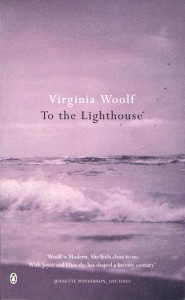Virginia Woolf is generally regarded as a difficult author to read and to be completely honest, she can be. The books and essays I have read of hers, required a second reading before I truly understood what she was trying to say. But don’t let that put you off. Woolf’s use of language is exquisite and a book like Mrs Dalloway, with its ‘stream of consciousness’ narrative is genuinely unique. To the Lighthouse is also a little different.
 The book is not plot driven instead what we get is detailed character development and an important social commentary of the time (it was first published in 1927). Woolf creates strong female characters in Mrs Ramsey and Mrs Dalloway, both formidable women who attract male and female admirers and then contrasts them with the men in their lives who tend to be controlling and tyrannical. These men require their egos massaged by the women and need to be looked after by them, but in return they tell women they are feeble minded and less able than men. Lily, an aspiring painter, gets told in the book that, ‘Women can’t paint, women can’t write.’ Naturally enough, this attitude made Woolf angry and it makes me angry too. Therefore, I sympathise with her views and understand why she wrote about this subject in so many of her stories and essays.
The book is not plot driven instead what we get is detailed character development and an important social commentary of the time (it was first published in 1927). Woolf creates strong female characters in Mrs Ramsey and Mrs Dalloway, both formidable women who attract male and female admirers and then contrasts them with the men in their lives who tend to be controlling and tyrannical. These men require their egos massaged by the women and need to be looked after by them, but in return they tell women they are feeble minded and less able than men. Lily, an aspiring painter, gets told in the book that, ‘Women can’t paint, women can’t write.’ Naturally enough, this attitude made Woolf angry and it makes me angry too. Therefore, I sympathise with her views and understand why she wrote about this subject in so many of her stories and essays.
In true modernist style, she also plays a little with the structure of the book. It is split into three sections. The first is a single day when the entire family and their friends are gathered at the Ramsey’s holiday home in the north of Scotland. The very short middle section rushes through time and arrives at its destination after the first world war during which the family have suffered many losses and finally, the third section tells of another day when they reconvene at the house, several years later, and finally get to go to the lighthouse across the water. The purpose of this is to show the difference between actual and perceived time, either one day lasting a lifetime or a lifetime flashing by too quickly.
To the Lighthouse is definitely a Classic and I would recommend you read it but read it slowly and take the time to think about it.
Enjoyed this review. I think Woolf is a bit like Hilary Mantel. Immersive and semi-psychic in a way that takes a while to adjust to, but once you do the stuff never leaves you. It’s felt rather than constructed.
LikeLike
Completely agree. I read Beyond Black by Hilary Mantel, 8 years ago, and still can flash back to that book. Took a bit of getting into but I reckon it will always be there now. The sign of a truly good read.
LikeLike
I adore Virginia Woolf. Her writing is utterly mesmerising. What is your favourite of her work?
LikeLiked by 1 person
I understand your love of her, I do too. Although I haven’t read everything she wrote as of yet, my favourite so far is Mrs Dalloway. I think she is an amazingly complicated character, thereby making her seem so real and each rereading gives me more and more. Mrs Dalloway feels real because we see all the different aspects of her consciousness and self.
LikeLike